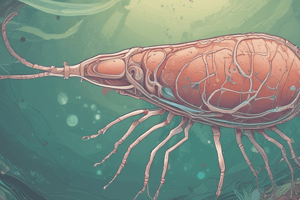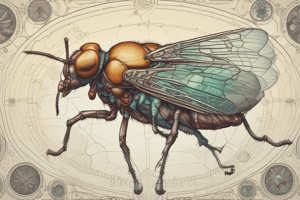Podcast
Questions and Answers
Which of the following symptoms is NOT associated with the entrance of fly larvae into human tissues?
Which of the following symptoms is NOT associated with the entrance of fly larvae into human tissues?
- Severe pain in the eye
- Nausea
- Numbness in limbs (correct)
- Boil-like lesions
What is the primary route through which larvae can enter human tissue?
What is the primary route through which larvae can enter human tissue?
- Entry through urinary or genital orifices (correct)
- Breathing contaminated air
- Ingestion of contaminated food
- Direct penetration through the skin
Which of the following flies is associated with causing ocular myiasis?
Which of the following flies is associated with causing ocular myiasis?
- Sarcophaga
- Dermatobia
- Wohlfahrtia (correct)
- Calliphora
Which symptom is typically a result of larvae invading the urinary tract?
Which symptom is typically a result of larvae invading the urinary tract?
Which of the following genera of flies is known to cause intestinal myiasis when their larvae are ingested through contaminated food?
Which of the following genera of flies is known to cause intestinal myiasis when their larvae are ingested through contaminated food?
What type of myiasis occurs when larvae invade living tissues?
What type of myiasis occurs when larvae invade living tissues?
What is a characteristic of obligatory tissue parasites?
What is a characteristic of obligatory tissue parasites?
In cases of purulent infections, which flies are typically attracted to the discharge?
In cases of purulent infections, which flies are typically attracted to the discharge?
What symptoms are associated with the presence of larvae in the eyes?
What symptoms are associated with the presence of larvae in the eyes?
Which of the following flies is known to deposit larvae in the urinary or genital orifices?
Which of the following flies is known to deposit larvae in the urinary or genital orifices?
What is one potential treatment method for infections caused by myiasis?
What is one potential treatment method for infections caused by myiasis?
In the clinical context, which action is essential for identifying the species of larvae?
In the clinical context, which action is essential for identifying the species of larvae?
Which context describes a patient with open wounds containing larvae?
Which context describes a patient with open wounds containing larvae?
What condition is caused by the intentional introduction of Piophila casei larvae into cheese?
What condition is caused by the intentional introduction of Piophila casei larvae into cheese?
What symptom might a person experience if larvae invade the nasal passages?
What symptom might a person experience if larvae invade the nasal passages?
What is one method of preventing healing and inducing sepsis in affected tissue?
What is one method of preventing healing and inducing sepsis in affected tissue?
What is a key characteristic of clinical symptoms when larvae invade different tissues?
What is a key characteristic of clinical symptoms when larvae invade different tissues?
Which method is NOT used for identifying the species of larvae in a clinical setting?
Which method is NOT used for identifying the species of larvae in a clinical setting?
Which option describes how larvae may travel to different body locations?
Which option describes how larvae may travel to different body locations?
What consequence might result from the presence of larvae in infected tissues?
What consequence might result from the presence of larvae in infected tissues?
Which is a primary prevention method to control myiasis in food?
Which is a primary prevention method to control myiasis in food?
What type of myiasis is characterized by larvae caused by specific species that feed on living tissue?
What type of myiasis is characterized by larvae caused by specific species that feed on living tissue?
In which scenario might an individual consume living maggots as part of a delicacy?
In which scenario might an individual consume living maggots as part of a delicacy?
What type of discharge is commonly associated with myiasis in the nasal region?
What type of discharge is commonly associated with myiasis in the nasal region?
What are the potential complications that larvae can cause when they invade the urinary tract?
What are the potential complications that larvae can cause when they invade the urinary tract?
Which of the following is true regarding the life cycle of myiasis-causing flies?
Which of the following is true regarding the life cycle of myiasis-causing flies?
Which conditions could lead to the development of ocular myiasis?
Which conditions could lead to the development of ocular myiasis?
What symptom is typically observed in cases of intestinal myiasis due to accidental ingestion of larvae?
What symptom is typically observed in cases of intestinal myiasis due to accidental ingestion of larvae?
Which flies are known for their ability to invade healthy skin and cause lesions?
Which flies are known for their ability to invade healthy skin and cause lesions?
What type of damage can larvae cause when they invade the brain tissue?
What type of damage can larvae cause when they invade the brain tissue?
What is a characteristic of obligatory tissue parasites among myiasis-causing flies?
What is a characteristic of obligatory tissue parasites among myiasis-causing flies?
How do larvae of certain flies typically enter the human body?
How do larvae of certain flies typically enter the human body?
Flashcards
Myiasis
Myiasis
Infection of human tissues by fly larvae (maggots).
How do maggots enter the body?
How do maggots enter the body?
Fly eggs or larvae can enter through open wounds, orifices (like the anus or mouth), or even intact skin.
Intestinal Myiasis
Intestinal Myiasis
Maggots reach the intestines after being ingested with contaminated food.
Urinary Myiasis
Urinary Myiasis
Signup and view all the flashcards
Cutaneous Myiasis
Cutaneous Myiasis
Signup and view all the flashcards
Ocular Myiasis
Ocular Myiasis
Signup and view all the flashcards
Ear Myiasis
Ear Myiasis
Signup and view all the flashcards
Obligatory Tissue Parasite
Obligatory Tissue Parasite
Signup and view all the flashcards
Oestrus Larvae
Oestrus Larvae
Signup and view all the flashcards
Conjunctivitis
Conjunctivitis
Signup and view all the flashcards
Corneal Ulcers
Corneal Ulcers
Signup and view all the flashcards
Accidental Cutaneous Myiasis
Accidental Cutaneous Myiasis
Signup and view all the flashcards
Specific Cutaneous Myiasis
Specific Cutaneous Myiasis
Signup and view all the flashcards
Treatment of Myiasis
Treatment of Myiasis
Signup and view all the flashcards
Maggot Entry
Maggot Entry
Signup and view all the flashcards
Intestinal Symptoms
Intestinal Symptoms
Signup and view all the flashcards
Urinary Problems
Urinary Problems
Signup and view all the flashcards
Accidental vs. Specific Cutaneous Myiasis
Accidental vs. Specific Cutaneous Myiasis
Signup and view all the flashcards
Myiasis: Clinical Picture
Myiasis: Clinical Picture
Signup and view all the flashcards
Myiasis: Diagnosis
Myiasis: Diagnosis
Signup and view all the flashcards
Myiasis: Treatment: Removing Larvae
Myiasis: Treatment: Removing Larvae
Signup and view all the flashcards
Myiasis: Treatment: Antiseptics and Antibiotics
Myiasis: Treatment: Antiseptics and Antibiotics
Signup and view all the flashcards
Myiasis: Prevention
Myiasis: Prevention
Signup and view all the flashcards
Study Notes
Myiasis
- Myiasis is the infection of human tissues by fly larvae (maggots).
- Myiasis is classified according to the site of invasion (internal or external) and the biological habit of the fly (specific, semi-specific, or accidental).
Internal Myiasis
- Intestinal Myiasis: Flies deposit eggs or larvae on food or the anus, particularly in children. Larvae enter the intestine, causing nonspecific symptoms (nausea, vomiting, abdominal pain, diarrhea). Living and dead larvae can be seen in stool or vomit. Common Example types: Calliphora, Lucilia, Musca, and Fannia.
- Urogenital Myiasis: Larvae enter through urinary or genital orifices, or sores in these areas. This can block urine flow, leading to dysuria (painful urination) and inflammation in the urinary tract, with pus, mucus, and blood in the urine. Larvae can be passed in the urine.
External Myiasis
- Cutaneous Myiasis: Larvae invade wounds or ulcers, or healthy skin, causing boil-like lesions. Severe damage is a potential complication. Common Example types: Wohlfahrtia, Chrysomia, Cordylobia (WC), Dermatobia, and Hypoderma.
- Ocular or Nasopharyngeal Myiasis: Larvae are attracted to eye or nasal discharge, reaching the conjunctiva or the nose and potentially the brain. Severe pain, tearing, and conjunctival irritation are common. Common Example types: Calliphora, Sarcophaga (CS), Oscestri, and potentially Musca.
- Aural Myiasis: Purulent ear discharge attracts flies, causing egg/larva deposition in the middle ear, inner ear, or even brain tissue (in severe cases). Common Example types: Wohlfahrtia, Sarcophaga, Lucilia, and Chrysomia.
Myiasis Classification by Biological Habit of the Fly
- Specific Myiasis (Obligatory): Larvae only invade live tissues (obligatory tissue parasites). Examples: Hypoderma and Dermatobia, causing skin swellings, eye issues (conjunctivitis), nose irritation/discharge, or ear infections.
- Semi-Specific Myiasis (Facultative): Flies commonly deposit and hatch larvae on dead tissues or on animals. Offensive body discharge can attract them to these areas, leading to larval invasion of inflamed wounds, eyes, or other tissues. Examples: Sarcophaga, Lucilia, Calliphora, Wohlfahrtia and Chrysomia.
- Accidental Myiasis (Pseudomyiasis): Fly eggs or larvae accidentally ingested in food, such as cheese and vegetables. Can also occur around the anal/urogenital area leading to intestinal or urogenital infestations. Examples: Piophila (in cheese), Drosophila, and Fannia.
Diagnosis of Myiasis
- Clinical picture based on the infected tissue
- Finding larvae in lesions
- Identifying larvae species based on spiracles
- Breeding larvae to identify adult fly type
Treatment of Myiasis
- Removal of larvae (excision or endoscopy)
- Treatment of secondary infections (antiseptics and antibiotics)
Prevention and Control of Myiasis
- Insecticides and nets to control flies
- Protecting food from flies
- Cleaning and dressing wounds with gauze
Questions
- Q1: Flies that often deposit larvae near the urinary/genital orifices: Fannia.
- Q2: A 22-year-old patient with a wound, offensive discharge, and larvae: semi-specific cutaneous myiasis.
Studying That Suits You
Use AI to generate personalized quizzes and flashcards to suit your learning preferences.




